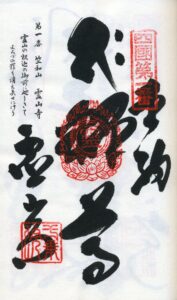Tip 8: The henro-outfit is available in shops near temple 1 and 10. Wear the clothes and become a pilgrim. With them on, you will be ‘blending in’, establish contact with the locals more easily, and receive gifts.
What does the outfit consist of?
There is no prescribed form in which you need to dress yourself for your pilgrimage. However, it is helpful to be recognizable as a pilgrim. You are most easily able to achieve this with your white hakui. The white colour will help everyone on Shikoku (and often outside the island too) identify you as a pilgrim. You could also purchase a pair of white trousers or wear one you brought with you. I chose a lightly tan, lightweight, long outdoor set of trousers.
The sugacasa, the rice hat, complete the image. And then you will need the signature kongozue, a walking stick. This walking stick will offer you companionship and support during the trek. It is a representation of Kobo Daishi, who will accompany you throughout your pilgrimage. The grip will be decorated with an ornate textile cover, which has a set of bells attached. Every step you will take will ring the bell, which will keep you in the present moment.
Doubts about the wagesa
If you so desire, you could complete the outfit with a prayer sash. I chose not to wear one, because with the sash comes a set of quite strict rules to abide by dictating when- and when not to wear it. For instance, you cannot wear it when going to the toilet, or while having a meal. I considered the risk of making mistakes too great, and consciously made the decision to abstain from wearing one.
Collect the stamps at the temples
As well as obtaining the proper clothes, it is also useful to buy a nokyocho. That is the book in which you can collect calligraphy (the first time you visit) and three stamps at each temple. This cost me 300 Yen per temple in 2019. However, the symbolic value of that book far exceeds the costs, because it provides me with a lasting connection to every temple. Keep in mind size and weight upon purchasing. You will need to carry it the whole way!

Everything in a temple bag
To keep all of the necessities required at the temples organised and easily accessible, I also bought a Zudabukuro, a bag which you wear on your stomach. It contained my nokyocho, candles, incense, my passport and wallet, and a small pouch in which I collected coins to offer as gift in the temple. I also put a selection of hand-written strips of paper, osame-fuda, which I could use in the temples. The fact that I had pre-written them also meant that I could quickly take one when I received o-setai. Giving someone one of these osame-fuda symbolizes the fact that you take the generous patron along on your henro in spirit.
Where to buy the henro-outfit?
There are pilgrims that order their outfit online. I chose to look for everything I would need in one of the shops around temple 1. If you stay in henro house Ichiban, the hostess will love to take you along to buy everything and provide you with an explanation. I did not do this, and I regret it. Martina, an Italian henro whom I met along the trek, had taken the hostess up on the offer and mentioned that she cherished the experience.
Aid with your purchase
Luckily, I received plenty of guidance inside the shop. The owner was clearly used to helping gaijin. He did not speak a single word of English but knew perfectly how to make everything clear to me. When I wanted to put on my temple bag, the owner quickly rushed over. He showed me how to wear it properly: if you put the carrying sling around your neck, the bag will rest on the bands of your backpack and that will keep it in front of you.
The days that I walked to temples without my backpack, this became a problem. I was so used to wearing the bag in that specific way, that I would also do it that way on those days… which resulted in it falling to the floor, because there was no backpack to hang it on. When I left the shop, I had lost quite a bit of money, but had gained an outfit. And I have worn that outfit with pride for almost two months.
The gift to the pilgrim: O-setai
Thanks to the recognizable outfit I received plenty of o-setai. Many people on Shikoku support the pilgrims. They do this in all kinds of ways. A gift to the pilgrim varies from giving directions to money and an offer of a free night’s rest. From some other pilgrims I heard that they felt that receiving money was a strange experience. To them it felt like begging in a way. I interpreted it as people offering you their support and putting trust in you. For a Buddhist it is comparable to offering money at a temple. And then I appreciate their signs of support.
